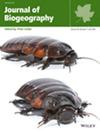Genomic Signatures of Ancient Vicariance in Host-Specific Fungal Endophytes Across the Soltis Line in the Pacific Northwest
Abstract
Aim
Foliar fungal endophytes are a highly diverse component of most plants, both in terms of taxonomic composition and function. Investigating the biogeography of these microbial symbionts in well-studied regions complements our understanding of the patterns and processes already inferred for animals and plants. Here, we investigated how past glacial cycles may have been responsible for a north–south pattern observed in the population structure of two foliar fungal endophyte species of the same genus, with similar life-history traits sharing the same potential hosts.
Location
Pacific Northwest, North America.
Taxon
Foliar fungal endophyte of pines: Lophodermium fissuratum and L. nitens (Rhytismatales, Leotiomycetes, Ascomycota).
Methods
We used genotype-by-sequencing (ddRADSeq), complemented with nuclear ribosomal sequences, to analyse population structure. We also tested four demographic scenarios with a composite likelihood approach to find whether vicariance or recent dispersal better explains the north–south pattern and estimated demographic parameters for the best-fit models, including divergence time.
Results
The north–south population structure was more defined for L. fissuratum than for L. nitens, which showed signs of isolation-by-distance. The best-fit models revealed the northern and southern populations for both species diverged before the Last Glacial Maximum, although L. fissuratum populations diverged long before those of L. nitens. Recent secondary contact was found for L. nitens while L. fissuratum populations remain isolated today. Gene flow after divergence was asymmetrical, mostly from south to north for both species. We also detected signs of past population growth for both species, most likely after bottlenecks.
Main Conclusions
The patterns of genetic differentiation across a north–south partitioning in the Pacific Northwest in these distantly related fungal endophyte species are both compatible with a vicariance model. Although these fungal endophytes share many life-history traits and the same hosts, there are important differences in their demographic history, which highlight the complexity of the processes underlying their population structures. The glacial refugia of the Pacific Northwest are a multikingdom phylogeographic phenomenon, known as the Soltis Line, that has previously included plants and animals, but now also includes Fungi.


 求助内容:
求助内容: 应助结果提醒方式:
应助结果提醒方式:


